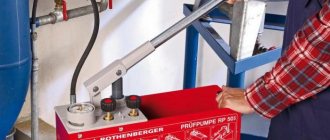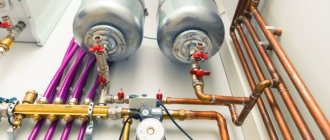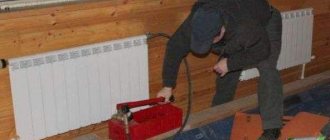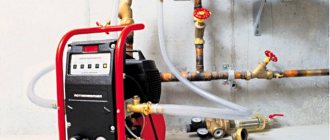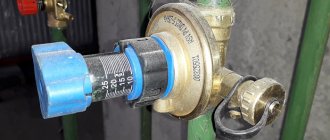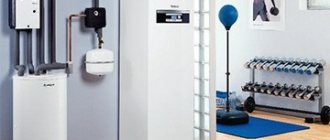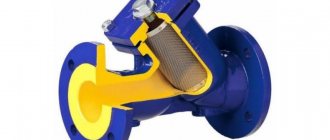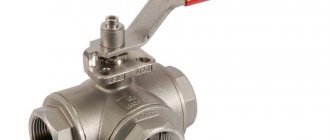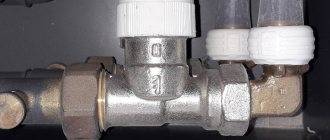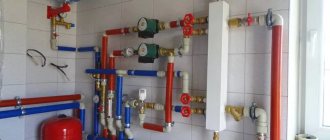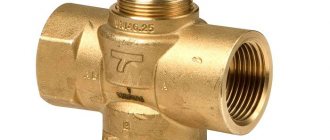Any heating system after installation or complex repairs needs to be tested for functionality; for professional purposes, a special pump is used for pressure testing the heating system, designed for testing heating systems under pressure. Pipes, various water intake tanks and mechanisms can be tested for leaks; water, antifreeze or hydraulic oil are used as the working fluid in these devices.
Pumps for pressure testing the heating system are used after installing all components and filling the pipes with liquid; the required pressure in the line (2 - 3 times more than the working pressure) is set using special limit valves and controlled by a built-in pressure gauge.
Rice. 1 Manual and electrical crimping equipment - appearance
Operating principle and purpose of a manual pressure testing pump
Heating can be checked for leaks by pumping air or liquid into the pipeline; in the first case, compressors are used to supply air for pressure testing of pipelines. The disadvantage of the air method is the difficulty of detecting leaks in crimp pipes; the pipeline design makes it easy to connect testing equipment using various types of liquids.
During hydraulic testing of heating systems in a line pressurized with a manual pressure test pump, the system operates for several hours under high pressure. Based on the method of injection, this equipment can be divided into two large groups: manual and electric.
Rice. 2 The principle of operation of the main unit of a mechanical pressure tester - a plunger pump
The manual pressure test pump has a simple design in the form of a sealed water tank with a plunger piston that applies pressure using a durable lever hinged to it.
The advantage of plunger pumps is the ability to obtain very high pressure due to the use of a durable and wear-resistant metal cylinder that is not susceptible to mechanical deformation as a pushing piston. The inner surface of the working cylinder, in which the cylindrical piston moves, is manufactured with high manufacturing precision - this made it possible to reduce the working gaps, the sizes of the sealing rings and, accordingly, increase the pressure of the hand pump.
To control operation, the unit is equipped with a pressure gauge; after pumping the liquid with the required pressure, the working chamber is isolated from the general system using a shut-off valve.
Manual crimpers are designed for checking small circuits; they are often used in dachas or country houses. They differ from their electrical counterparts in their low cost and slow operation.
Rating of quality crimpers for 2021
Our top list is compiled based on real reviews, it takes into account the opinions of customers familiar with the product, its functions, and features. Here you will find photos and tables of characteristics.
Inexpensive
Zitrek TH-25
The Zitrek TH-25 hand-held device is a high-precision plumbing tool used for hydrodynamic testing of pipeline structures and communications services. "Zitrek TH-25" is used for certification of equipment after installation and repair work in the construction and housing and communal services sector.
The device is capable of pumping water, antifreeze, oil. The device kit includes: pressure gauge, sleeve. "Zitrek TH-25" is used as a hydraulic mechanism as part of more complex units.
Technical indicators:
ParametersCharacteristics
| Maximum fluid temperature | 80 °C |
| Volume of the tank | 5 l |
| Type | Manual |
| View | Specialized work |
| Test pressure | 30 bar |
| Connection to pipeline | External G1/2 |
| Working fluid | Water, oil |
| Rotor | Dry |
| Weight | 3 kg |
| Dimensions | 320x200x260 mm |
| Permissible fluid temperature | from +5 to +80 °С |
| Series | T.H. |
| Weight of packaged goods, kg | 1.99 |
| Dimensions of packaged goods, mm | 321 x 192 x 122 |
Zitrek TH-25Advantages:
- designed to increase pressure in pipelines (functions only as a testing tool to check for leaks);
- pressure gauge;
- small dimensions, weight;
- comfortable handle;
- can act as a hydraulic drive for various devices.
Flaws:
- not detected.
HSY30-5
The HSY30-5 testing device is capable of quickly and fairly accurately testing the tightness of sewers, pipelines, and other closed circuits. The mechanism is suitable for servicing solar batteries. Constant pressure is generated thanks to the reliable design of the device. It includes an ergonomic valve that regulates the opening of the valves, a brass piston and a casing.
Due to the filter located at the inlet, the HSY30-5 is protected from damage caused by dirt entering the system. The mechanism is distinguished by its small dimensions and mobility; the manual drive allows you to avoid searching for a power source at the construction site. The set is complemented by a metal container with anti-corrosion coating.
Technical indicators:
ParametersCharacteristics
| Volume of the tank | 12 l |
| Type | Manual |
| Test pressure | 60 bar |
| Connection to pipeline | External G1/2 |
| Working fluid | Water |
| Rotor | Dry |
| Weight | 7.8 kg |
| Dimensions | 500x190x140 mm |
| Series | HSY |
| Housing material | Steel |
| Product unit | Thing |
| Weight of packaged goods, kg | 7.5 |
| Dimensions of packaged goods, mm | 520 x 200 x 310 |
HSY30-5Advantages:
- pressure gauge data is read while the equipment is operating;
- brass piston and valve body ensure long service life;
- efficiency 45 ml/cycle;
- compact, lightweight, ideal for mobile use;
- unique valve system maintains constant pressure
- The input filter increases operational reliability.
Flaws:
- not detected.
Rotor Test Mini
The hand-held tester “Rotor Test Mini” is used to test the tightness of water-carrying communications with a pressure of up to 25 bar; the device has a metal tank with a capacity of 5 liters. The device is able to quickly “pressure test” the heating system. "Rotor Test Mini" is used for testing leaks inside air circuits, refrigerators, oil and sprinkler structures, and other closed installations. The pressure gauge included in the kit is easy to read. The holder has a rubber pad that allows you to carry the device more comfortably.
Technical indicators:
ParametersCharacteristics
| Max liquid temperature | 60 °C |
| Volume of the tank | 5 l |
| Type | Manual |
| Test pressure | 25 bar |
| Connection to pipeline | External G1/2 |
| Working fluid | Water |
| Rotor | Dry |
| Weight | 7 kg |
| Dimensions | 320x210x260 mm |
| Permissible fluid temperature | from +5 to +60 °С |
| Housing material | Steel |
| Weight of packaged goods, kg | 3 |
| Dimensions of packaged goods, mm | 32 x 21 x 26 |
Rotor Test MiniAdvantages:
- compactness;
- metal casing (reservoir);
- comfortable rubberized handle;
- high-precision pressure gauge that controls parameters;
- The piston is made of strong brass that is resistant to corrosion.
Flaws:
- not detected.
Average
Rothenberger RP 50
The manual German unit “Rothenberger RP 50” is used for accurate, quick testing of working pressure, tightness of water supply structures, tanks, heating and plumbing equipment, compressors, steam, cooling, and oil units. The device generates pressure in the test space, after which the operator closes the shut-off valve and observes whether the pressure gauge readings drop. This is how it is determined whether the water supply structure or container is airtight.
Constant pressure inside the unit is ensured thanks to 2 valves and stainless steel ball spindles. "Rothenberger RP 50" has a reliable tank with a capacity of 12 liters made of galvanized sheet steel, which can successfully withstand mechanical damage, harmful environmental influences, freezing, and does not rust. The machine has a metal piston, a 0-60 bar pressure gauge, and the set includes a connecting fitting with a 0.5-inch nut.
Technical indicators:
ParametersCharacteristics
| Max liquid temperature | 50 °C |
| Volume of the tank | 12 l |
| Performance | 0.045 l/min |
| Type | Manual |
| Test pressure | 60 bar |
| Connection to pipeline | Internal G1/2 |
| Working fluid | Water, oil |
| Rotor | Dry |
| Weight | 8 kg |
| Dimensions | 720x170x260 mm |
| Permissible fluid temperature | 50 °C |
| Series | RP 50S |
| Housing material | Steel |
| Weight of packaged goods, kg | 7.91 |
| Dimensions of packaged goods, mm | 535 x 195 x 357 |
Rothenberger RP 50Advantages:
- meets the high requirements of German quality workmanship;
- icing resistance;
- wear resistance;
- tank volume 12 l;
- consumption about 45 ml/cycle;
- connector R 1/2”;
- control hose with fabric braid;
- reduced risk of measurement errors due to the quality of the hose;
- the ability to use a pressure gauge with a precise scale (0.1 bar) for testing up to 16 bar;
- high performance;
- fast filling with long stroke;
- ergonomic handle;
- The pressure gauge needle accurately indicates the set pressure, so the pressure drop is easy to determine.
Flaws:
- not detected.
NR-60
The manual testing device “NR-60” was manufactured by a Russian company; the device is equipped with a container and is used to test the tightness of pipes and tanks. The unit can withstand pressure up to 60 bar (6 MPa). “NR-60” is a multi-tasking instrument; its measuring instruments are located conveniently for the operator monitoring the readings of the main parameters.
The casing of the device is resistant to rust, it is comfortable to move from place to place, and in case of long-term storage it can be packed. The device is capable of pumping water, mineral oil, antifreeze. The “NR-60” set includes: a 12-liter tank, a high-precision pressure gauge, and a 1.5-meter long hose that can withstand increased pressure. The unit will be needed in case of certification of various buildings and structures.
Technical indicators:
ParametersCharacteristics
| Brand | Reference |
| Working environment | Water, oil |
| Performance | 15ml/stroke |
| Working fluid pressure, MPa | 6 |
| type of drive | Manual |
| Installation method | Outer |
| Tank capacity, l | 12 |
| Weight, kg | 11.04 |
| Overall dimensions, mm | 615x205x315 |
NR-60 manual pumpAdvantages:
- rust resistance;
- works with water, oil.
Flaws:
- not detected.
Rekon
The manual tester "Rekon" is used for testing work. Due to the generation of water pressure, factory-made and home-made closed circuits are checked for leaks (heat supply, sewerage, solar batteries, refrigerator compressors. The device is capable of pumping oil, and is used during the production of boilers, compressed gas cylinders; pressure tanks, checking sprinklers.
Technical indicators:
ParametersCharacteristics
| Max liquid temperature | 60 °C |
| Volume of the tank | 12 l |
| Performance | 3 l/min |
| Type | Manual |
| Test pressure | 60 bar |
| Connection to pipeline | External G1/2 |
| Working fluid | Water |
| Rotor | Dry |
| Weight | 8 kg |
| Dimensions | 500x190x290 mm |
| Minimum fluid temperature | -30 °C |
| Housing material | Metal |
| Weight of packaged goods, kg | 8 |
| Dimensions of packaged goods, mm | 510 x 200 x 310 |
Rekon test pumpAdvantages:
- durable, comfortable metal construction for heavy-duty use;
- corrosion-resistant powder-coated metal tank;
- lever with an ergonomic handle used during carrying;
- wear-resistant brass construction with a one-piece shut-off valve and a pressure gauge with an accurate scale for reading changes in parameters;
- 2-valve ball system made of stainless steel increases reliability;
- high performance during long lever strokes and accuracy during short strokes;
- Flexible, reinforced high-pressure braided hose increases accuracy of readings.
Flaws:
- not detected.
Expensive
Rothenberger RP Pro 3
We bring to your attention an automatic crimping machine for testing “Rothenberger RP Pro 3”, powered by electricity. It is used during testing of pipelines, water supply tanks, heating, air conditioning, fire fighting, sewerage, irrigation structures, solar panels, other hydraulic and pneumatic systems, in the manufacture of pressure tanks, industrial boilers. The machine can withstand up to 40 bar.
Technical indicators:
ParametersCharacteristics
| Voltage | 220 – 240 V |
| Frequency | 50 / 60 Hz |
| Weight | 16 kg |
| Power | 1300 W |
| Current strength, A | 6 A |
| Pressure | 0 – 40 bar, scale division 1 bar |
| Dimensions (L*W*H) | 380 * 290 * 300 mm |
| Threaded connection | R 1/2′ |
| Performance | 6 l/min |
| Protection class | IP 32 |
| Noise level | 90 dB |
| High pressure hose length | 1.2 m |
| Engine oil | SAE 15W/40 |
| Supply hose length | 2 m |
| Maximum fluid temperature | + 40°C |
Rothenberger RP Pro 3Advantages:
- compact, durable plastic case, convenient to use on any construction site;
- strong, reliable single-phase four-stroke electric motor with a power of 1.3 kW;
- thermal switch prevents overload and damage to the pump;
- the test hose has a steel braid, preventing leakage during measurements;
- glycerin pressure gauge compensates for pneumatic shocks, making it easier to read readings during dynamic loads;
- pressure control valve with precise markings on the handle;
- automatic filling, leak testing of pipelines and tanks;
- free choice of liquid supply type: self-priming or pump;
- quick overview of functions;
- used for water, oil, glycol, "typhocor".
Flaws:
- not detected.
OGS-100 EP-40
"OGS-100 EP-40" is a device with an electric drive for testing aquifer structures. It is used for pressure testing of tanks of various sizes and pipelines. "OGS-100 EP-40" operates in the Russian climate, in the ambient temperature range from 10 to 35 degrees. This series has category “U”, GOST 15150-69.
The machine has the following features:
- checking the strength of pipes and engineering structures after installation or repair;
- applied during the commissioning of heating networks;
- detects leaks in heaters;
- used during the installation of pressure tanks.
Precautionary measures:
- avoid contamination of the unit and hydraulic fluid;
- use only clean drinking water or oils “VMGZ”, “I-12A”, “I-20A”;
- Check and clean the inlet filter periodically.
- After operation and long-term storage, always remove water from the hydraulic system by pumping it in a waiting manner for a few seconds;
- You cannot work with water at temperatures below 0 degrees;
It is important to pay attention to the presence of lubricant in the built-in grease nipples and on each of the three cavities of the machine piston.
Technical indicators:
ParametersCharacteristics
| Maximum head | MPa (kgf/cm²) 10/100 |
| Capacity, l/min | 40 |
| Overall dimensions LxBxH, mm | 730x400x650 |
| Overall dimensions of the water tank LxBxH, mm | 390x310x150 |
| Tank volume, l | 15 |
| Presser weight, kg | 50 |
| Rated power, W | 2200 |
| Voltage, V/Hz | 220÷240 / 50 |
| Water supply | Clean drinking water, max. temperature 40° C |
| Length, mm | 2500 |
| Inner diameter, mm | 18 |
| High pressure hose dimensions: | |
| Length, mm | 1500 |
| Connecting hose to the system under test, inches | 1/2″ conical outer |
| Drain hose, mm | 2000 |
OGS-100 EP-40Advantages:
- 12 month warranty;
- electric drive;
- power 2200 W.
Flaws:
- not detected.
MGF Compact 60 905200
"MGF Compact 60" works thanks to an electric drive, withstanding up to 60 bar. The unit was created by an Italian company for crimping, filling, pumping liquid and non-acidic substances inside hydraulic structures. The increased pressure is generated by the powerful pistons of the mechanism. The reliable device can successfully resist rust and has a strong motor. Advantages of the electric device “MGF Compact 60”:
- the small weight of the device facilitates its faster transportation;
- reliable motor with power reserve;
- universal (EN 837) glycerin pressure gauge with 3 different scales in basic units of measurement guarantees the accuracy of the readings;
- no need to connect to a compressor;
- fittings made of stainless steel, brass;
- there is a filter element at the inlet, which reliably protects against dirt;
- insulation class IPX5, work S1.
Technical indicators:
ParametersCharacteristics
| Gross weight | 15.2 kg |
| Pressure gauge | + |
| Max. pressure | 60 bar |
| Voltage | 220 V |
| Performance | 7 l/min |
| Power, W | 1750 |
| Manufacturer country | Italy |
| Current frequency, Hz | 50 |
| Overall dimensions, mm | 200x440x320 |
MGF Compact 60 905200Advantages:
- accurate pressure gauge;
- overheat protection;
- Convenient holder ensures comfortable carrying.
Flaws:
- not detected.
Structural device of a manual pressure testing pump
A typical manual pressure test pump for a heating system consists of:
- pressure part 1 with handle 5 installed on the cover 6 of tank 2.
- A pressure hose 3 is connected to the outlet of the injection unit, which is connected through a special fitting to the line under test.
- Plunger pump 1 is the main unit of the unit and includes a cylindrical head 4, a distribution fitting 15, internal valves, two valves 7 and 8.
- Valve 7 opens and closes the hole for draining the liquid, and valve 8 serves to turn off the device after the required pressure is pumped into the line.
- Water enters the system under test through a cylindrical head 4 and a liquid suction pipe 10 with a filter placed at the end, secured with a nut 11.
- For ease of use, the side of the tank is equipped with a hook for attaching a handle, which is also used for carrying the unit.
- To monitor equipment pressure, the device is equipped with a built-in pressure gauge 9 with a dial indicator.
Rice. 4 Design of a manual hydraulic crimping machine
Mechanical
A manual pressure tester consists of a system of hoses, indicators, a handle for creating pressure and a housing in which it all is located. Such equipment can also be used as a drive for clamps and hydraulic tools. Their importance is extremely important in those places where there are problems with electricity and water supply.
The advantages of such a device are many times greater than the disadvantages. Compact dimensions, the ability to use in limited space, durability and reliability completely cover the fact that they can only work with small volumes. Despite the fact that such a pump requires the use of human muscles, it is the best option today.
Procedure for working with a manual crimping machine
When working with a hydraulic manual crimping machine, follow the given procedure and follow the following rules:
- Remove air from the pressure units of the pressure testing pump. To do this, fill tank 2 with working fluid to the mark specified in the instructions and open shut-off valve 8, after which water is pumped several times until it comes out of pressure hose 3.
- Connect pressure hose 3 to the line under test. For connection, use an adapter fitting or nipple, included with the unit or purchased separately.
- Liquid is injected. Using gaskets, close all holes in the line and pump water until the required pressure is reached, then turn shut-off valve 8 until the tests are completed. Usually the test is carried out within several hours; some specialists run the pump during pressure testing for almost a day; a pressure drop indicates a leak in the system.
- Disconnect the pressure tester from the pipeline. To do this, open the drain valve 7 and wait for the water to completely flow back into the tank; at the end of the process, the drain valve is closed to prevent dirt particles from entering the pump. Disconnect the pressure hose from the inlet pipe of the main, lower it into the tank and release the injection units from water by opening valve 8.
Rice. 5 Example of using pumps for pressure testing in the tested line
To avoid corrosion of the parts of the pressure tester, it is recommended that after emptying it of water, pour a little machine oil into the tank and pump the pump several times - next time the pressure test of the heating system will take place in internal parts that have been cleared of moisture and corrosion. At the end of the work, the oil can be drained and reused in the future to clean the pressure tester.
What to look for when buying basic characteristics
Productivity or feed
This is a value showing how much liquid the pump moves through itself per hour. Measured in m3/h. These data can be found in the technical document for the pump.
Multiply the volume of liquid in your pipes by three - and you will find out the approximate value of productivity.
Those. an approximate figure for a small village house will be 1 - 2 m3/h.
Performance of circulation pump Askoll ES2 70
A more accurate calculation is made using the formula:
Q=Qn/Dt
Q - desired feed
Qn – how many kilowatts of energy are needed for a given area (in kW)
Dt is the temperature difference between the boiler outlet and return.
Pressure
The second, no less important indicator. The more complex and longer the pipeline (the more turns, radiators, fittings and taps it has), the greater the pressure the pump should have.
It is clear that if there is insufficient pressure, the pump simply will not perform its functions, and if there is excessive pressure, noise will appear in the system from the rapid movement of liquid.
Pressure and flow characteristics of the pump
The pressure can be calculated using the following formula:
Hpu =R x L x ZF / 10000
R – losses caused by pipe friction (Pa/m)
L – pipeline length
ZF – coefficient for valve (1.7), fittings (1.3)
If all these calculations seem too difficult and confusing to you, there is a plan B. Buy a pump with a reserve of pressure and flow (which, of course, leads to unnecessary expenses), but you can always simply switch the unit to a lower speed if it is working too hard.
Connection size
The diameter of the pipes and the diameter of the inlet holes on the pump may not match. This, of course, can be corrected with the help of adapters, but it will be less troublesome if the section sizes are chosen to be the same. In the specifications for heating circulation pumps, the diameters are indicated in inches.
Power
Remember that your heating circulation pump will be turned on quite often and for a long time, so high power can be ruinous. Nowadays they make very economical units that consume electricity like a regular light bulb.
Selection of a circulation pump based on power parameters
Other nuances
Automation for the heating circulation pump (automatic regulator) will help save electricity. Then the pump will work “according to the needs” of the system.
When buying an imported pump on the Internet, it is a good idea to make sure that it operates on a 220 V network (and not 380, for example).
And look at the service life of the pump - it should not be less than 10 years.
What volume of systems are checked?
If a multi-storey building is subject to inspection, then the airiness indicators may be so high that hundreds of movements with the lever will not be enough to pump 1 liter of liquid into the system.
a manual crimper with such a volume . Manual type equipment is recommended for use in cases where checks are required occasionally. It will also be effective for inspecting your own home with small amounts of work. It will be no less useful in the case of inspections in places remote from energy sources.
The device of a manual crimper is so primitive that even an unenlightened person can figure out the connection and operation procedure.
Buying such a device today will not be difficult. A wide range of equipment for crimping is presented in the catalog.
If you are unsure that you can make the right choice yourself, then our specialists will advise you free of charge.
If you have already chosen the model you like, then you can order it in a couple of clicks. A personal offer awaits you on our website - there is a discount on each next product.
Operating principle
To carry out a full check, you will need to fill the circuit (section) of interest to the master with clean liquid. It is worth noting that no matter what liquid is used, the pump reservoir must also be filled. The indicators are recorded only after the maximum circuit fullness has been reached. This can be seen using the control relay. The whole procedure will take two to three hours. At the same time, all performance indicators must be at an optimal level, ensuring stability. After a certain period of time has passed, the data is taken and compared with the primary figures. Different models will require different amounts of time to collect data, which can complicate the work in some conditions. Each network will need its own pressure range. As a result, a conclusion is drawn that indicates the need for further examinations. If the final and initial data differ, there may be a leak in the system.
How to make the right choice?
At the moment, the market is filled with a wide variety of models of crimping equipment .
To make the right choice, certain calculations of factors such as the total length of the communications being tested, the period and frequency of testing, and the time allotted for them are required.
If the work is one-time, then it would be a good idea to rent the equipment. The operating time with crimping directly depends on the pump power. But it is worth remembering that low-power crimping machines cannot give an accurate result in the event of depressurization of seams. For example, it will be impossible to check a high-rise building with a low-power pump. To check a private living space, a power of up to 4 l/min is enough. However, for a mansion you will need up to 6 l/min.
For the correct choice, the maximum pressure of the equipment is no less important. In accordance with the heating main regulation, each private house must be checked with individual pressure.
In order not to overload the pressure tester, it is necessary to correctly calculate the amount of work with its technical characteristics, but at the same time it should not create a pressure below the stable one.
Recommendations for future use
Before starting work, you must carefully check all elements of the equipment.
Checking measuring instruments and calibrating them if necessary.
Checking the tightness of the hoses and the functionality of the control unit.
General assessment of the crimper’s capabilities for working at the upcoming site.
Compared to the mechanical one, the electric version has an advantage because it has a large power reserve and is capable of pumping up pressure several times greater.
It is worth remembering that the range of operating temperatures in which the crimper can be used ranges from 6 to 40 degrees.
